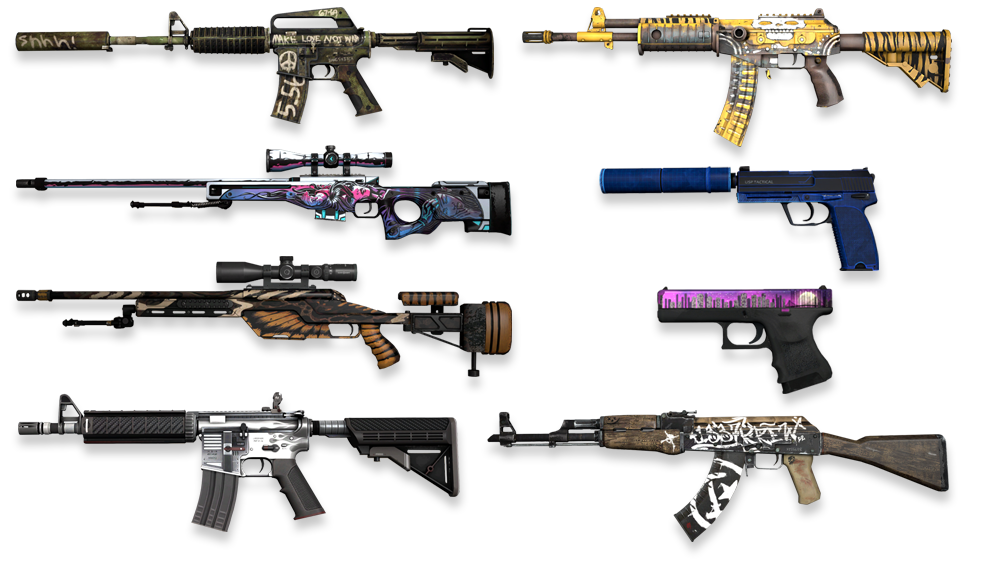Bedding Insights
Exploring the latest trends and tips in bedding and sleep comfort.
Skin Deep: Why CSGO Weapon Skins Are More Than Just Pixels
Discover the hidden value behind CSGO weapon skins and why they hold more power than just pixels in the gaming world!
The Economics of CSGO Weapon Skins: How Pixels Turn into Profit
The world of CSGO weapon skins has transformed beyond its aesthetic appeal, evolving into a lucrative marketplace where digital items can yield real-world profits. Players often view these skins not merely as cosmetic upgrades, but as valuable assets that can appreciate over time. The rapid growth of the market has attracted both gamers and investors, intrigued by the prospect of trading unique skins. With thousands of skins available, some rare variations can fetch thousands of dollars, leading enthusiasts to treat them as collectibles, akin to rare trading cards or vintage memorabilia.
At the heart of this economy is a sophisticated system of supply and demand. The scarcity of certain skins, combined with community interest, drives their prices skyward. Platforms like OPSkins and Steam's Marketplace have facilitated this trading culture, allowing players to buy, sell, and exchange their CSGO skins seamlessly. As the player base continues to grow, so does the economic framework surrounding these digital goods, with some players even considering their inventory as a form of investment. Ultimately, the economics of CSGO weapon skins highlights the fascinating intersection of gaming, commerce, and consumer psychology.

Counter-Strike is a highly popular tactical first-person shooter game that pits teams of terrorists against counter-terrorists. Players can choose from a variety of weapons and skins to customize their gameplay experience, such as the cs2 zeus skins, which add a unique flair to the iconic Zeus X27 weapon.
Crafting Identity: The Psychological Appeal of CSGO Skins
The world of CSGO skins extends far beyond mere aesthetics, tapping into the deep psychological need for identity and self-expression among players. These virtual items provide a unique canvas for gamers to showcase their individuality, reinforcing their status within the community. Through the acquisition of rare and highly coveted skins, players are not just enhancing their gameplay experience; they are also crafting a narrative around their gaming persona. This phenomenon is a part of a broader trend where in-game items become symbols of prestige, allowing players to communicate their style and achievements without uttering a single word.
Moreover, the allure of CSGO skins is amplified by the game's vibrant trading market, which adds a layer of economic strategy to the mix. Players are driven by the thrill of hunting for the most coveted designs, leading to an intense emotional investment in their collections. The gamification of trading, combined with community validation through social media and streaming platforms, creates a feedback loop that reinforces the psychological appeal of these virtual items. As players seek to enhance their in-game identity, the value of CSGO skins transcends their visual appeal, becoming integral to their overall gaming experience.
Are CSGO Weapon Skins the New Digital Art? Exploring Their Value in the Gaming Community
The debate surrounding whether CSGO weapon skins can be considered the new form of digital art has gained significant traction within the gaming community. Much like traditional art, these skins are not just mere cosmetic upgrades; they represent a unique blend of creativity, community involvement, and market dynamics. Artists and designers put substantial effort into developing these visuals, often drawing inspiration from various cultures and trends. As players express their individuality through these skins, they elevate the in-game experience, transforming each weapon into a canvas showcasing personal style and identity.
Moreover, the value of CSGO weapon skins is inherently linked to their rarity and desirability. Some skins can fetch thousands of dollars on the marketplace, mirroring the art auction scene where unique pieces reach staggering prices. This aspect has led to a thriving economy around skins, sparking discussions on ownership and digital property rights in the gaming world. As collectors continue to acquire skins as a form of investment, it becomes evident that these virtual items are not just ephemeral assets; they hold a significant place in the evolving landscape of digital art within the gaming community.